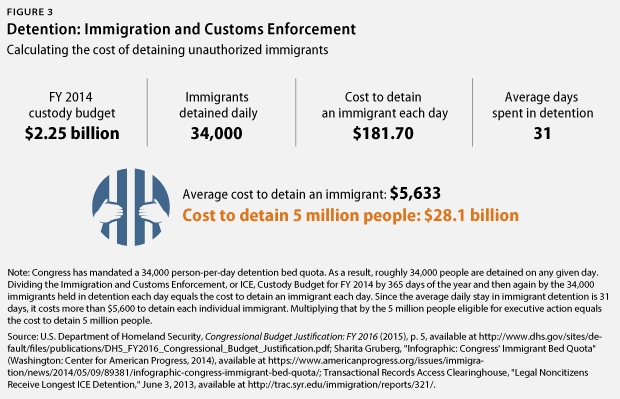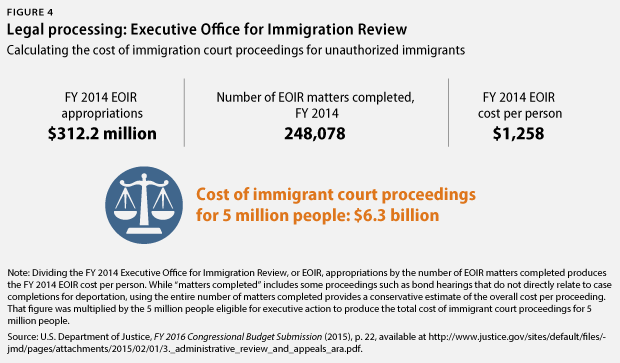This charticle contains a correction.
One month ago, the House of Representatives passed a funding bill for the U.S. Department of Homeland Security, or DHS, that if enacted, would end the immigration directives announced by President Barack Obama on November 20, 2014. Ending executive action would place 5 million people—the majority of whom are young DREAMers or parents of citizens or permanent residents—back in the crosshairs for deportation.
Putting aside the strong support among American voters for providing a pathway to legal status for these groups, most people do not believe that the United States would have the will or the resources to deport all 5 million potential beneficiaries.
But what would it actually take to achieve the end result of the action that the House of Representatives is pushing—for the nation to deport these 5 million people? In 2010, the Center for American Progress published a report estimating the cost of deporting the entire undocumented population. Updated calculations from that report appear below, taking into account the subset of the undocumented population that is now eligible for executive action.
The cost of deporting the beneficiaries of the recent DHS immigration directives would likely be greater than the average cost of deportations. Given that beneficiaries of the programs must have been in the country for at least five years, deportation would require costly interior removals rather than the less resource-intense removals that occur as people attempt to cross the border.
Put simply, it would cost more than $50.3 billion dollars to deport this entire population—an average cost of $10,070 per person. The figures below break down the factors that contribute to deportation costs.

Why is this estimate higher than those of DHS or Politico and lower than CAP’s previous estimate?
DHS
DHS says it costs $8,661 to deport a single immigrant. But in any given year, roughly two-thirds of all deportations are of people attempting to cross the U.S.-Mexico border, whereas only one-third are of people actually living in the interior of the United States. It takes more time, effort, and resources to apprehend someone who has been living in the country for years under the radar—and the contemporary unauthorized immigrant population has been living in the country for an average of 12.7 years. The long-settled nature of this population, the fact that to qualify for the Deferred Action for Parents of Americans and Lawful Permanent Residents, or DAPA, program individuals must have children, and the fact that in order to be eligible for any of the programs, applicants must not have committed serious offenses mean that members of this population are deeply rooted in their communities.* CAP’s new estimate for deporting the immigrants eligible to be shielded by the DHS directives, $10,070 per person, takes these higher enforcement costs and long average length of residence into account in order to produce the most conservative estimate possible.
Politico
Politico estimated that it would cost between $20 billion and $25 billion to deport those eligible for executive action. Because it only believes that 3 million of the 5 million who are eligible would come forward, however, its full deportation costs are based on a smaller population. Since the CAP analysis—and ostensibly Politico’s as well—considers the deportation of the entire executive-action-eligible population, there is no reason to assume that only 3 million out of 5 million people would be deported if the executive actions were overridden. The CAP calculation takes into account the entire eligible population, resulting in a total cost of $50.3 billion.
CAP’s 2010 estimates
In 2010, CAP estimated that it would cost $23,482 to deport a single person. In 2011, however, DHS changed how it reported apprehensions, adding in people caught by the Secure Communities program.This change ultimately led to far more apprehensions being reported as part of ICE Enforcement and Removal Operations. Apprehensions in FY 2010, for example, jumped from 35,774 people prior to the inclusion of those caught through the Secure Communities program to 270,635 people following this change. The increased number of apprehensions meant that the overall ICE budget was divided among a larger number of people, leading to a lower per-person deportation cost and a corresponding shift in the cost estimates.
Because the Secure Communities program has led to a significant portion of total apprehensions over the past few years, using these updated figures provides a more accurate—but still very conservative—estimate of per-person deportation cost. This updated analysis also does not include costs for the Office of Domestic Investigations, or ODI, a part of Immigration and Customs Enforcement that deals with serious offenses such as human smuggling, gang activity, and immigration fraud. Given that individuals must not have committed a serious offense in order to qualify for executive action, ODI would likely be only tangentially involved in apprehending this population.
The deportation process consists of four administrative functions: apprehension, detention, legal processing through immigration courts, and transportation.




Even disregarding the immense harm to individuals, families, and communities that would result from deporting 5 million DREAMers and their parents, $50.3 billion dollars is a significant expenditure—more than the annual budget of more than half of the cabinet-level government agencies and larger than the gross domestic product, or GDP, of more than 100 countries. And this high cost would come on top of losing the significant future economic gains created by the president’s executive action if the beneficiaries are deported: $22.6 billion in payroll taxes over five years, $41 billion added to the Social Security system over one decade, and $210 billion in additional GDP over one decade.
Instead of pretending that the United States will deport all 5 million individuals shielded by the president’s executive action, Congress should come together and pass an immigration reform bill that puts them on a path to legal status, toward becoming full and equal members of society.
Philip E. Wolgin is Associate Director for Immigration at the Center for American Progress. He would like to thank Marshall Fitz, Patrick Oakford, and Silva Mathema for their help in conducting this analysis.
* Correction, February 23, 2015: This charticle has been updated to reflect the correct full name of the DAPA program, which the Department of Homeland Security has updated. The correct name is Deferred Action for Parents of Americans and Lawful Permanent Residents.